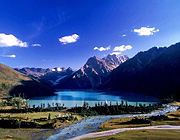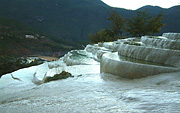China Trekking
Delivering Valued Experience to Adventurous Travellers...
Shangri-La (Zhongdian)
Shangri-La (Zhongdian) Travel Guide, Yunnan
Overview
It was the British writer James Hilton's novel, The Lost Horizon, some 50 years ago, that brought fame to an unknown and uncontaminated place- Shangri-La - a household name. The novel described in great detail the stunning scenery in the area: the azure sky, the breathtaking beauty and the hospitality of unsophisticated people.In Tibetan, Shangri-La means a place of good fortune and luck.
Although a romantic name, Shangri-la does not actually refer to any specific place. The official name of Shangri-La is Diqing Tibetan Autonomous Prefecture, which includes Zhongdian County as its capital and tourist base, Deqing County and Weixi County. The Shangri-La tour starts and ends both in Zhongdian, and this is also the transportation, cultural and commercial center.
Best time to go
Mid-April to mid-June. Rainfall is light and the colorful countryside wildflowers are blooming. Mid-September to November - Blue skies and crisp, refreshing air.
Highlights
Scenic Beauty/Songzanlin Monastery/Baishui Terrace/Zhongdian Old Town
Getting there & away
- By Air
The newly built Zhongdian Airport has a daily flight to and from Kunming. The flight is currently the hottest flight in Yunnan, so make sure you reserve in advance! The flight takes about 1 hour.
The airport is located 5km southwest of Zhongdian County Town. The best way to get to the airport is by taxi, which takes around 20 minutes and costs between Y15-20.
- By Bus
There are two bus stations in Zhongdian. The largest station is on the intersection of Changzhen Road and Jiantang Road. The station has buses to and from most tourist destinations. The detailed schedule is as follows:
| From Kunming | The South Station | 8:20am | Express | 14 Hours Y 220 |
| The Western station | 9am | Express | 14 Hours, Y 220 | |
| Huangtupo Station | 3pm 7pm | Sleeper | 16 Hours, Y 160 | |
| From Dali | Main Station in Xiaguan | 9am / 3pm | Express | 8 Hours, Y80 |
| From Lijiang | Main station | 7am-3pm (one bus per hour) | Mini bus | 5 hours, Y35 |
| From Panzhihua | Main station | 11am | Sleeper | 14 hours, Y115 |
From Zhongdian:
| Destination | Bus Type | Schedule | Time | Fare |
| Kunming | Express | 9:00 | 13hr | Y222 |
| Normal Sleepers | 16:00, 18:00 | 15hr | Y167 | |
| Lijiang | Normal bus | 13 buses from 7:10 to 17:40 | 5hr | Y35 |
| Xiaguan (Dali) | Normal Bus | 12 buses till 12:30 noon | 8hr | Y56 |
| Sleeper | 18:30 ,19:30 | 8hr | Y72 | |
| Express | 13:00 | 7hr | Y80 | |
| Weixi | Normal bus | 7:10 | 8hr | Y31 |
| Deqin | Normal bus | 7:20, 8:20, 9:20,12:00 | 6hr | Y38 |
| Bengzilan | Normal bus | 13:00, 14:00 | 3hr | Y17 |
| Xiangcheng (Sichuan) | Normal bus | 7:30 | 9hr | Y65 |
| Derong (Sichuan) | 8:00,9:00 | Y37 | ||
| Daocheng (Sichuan) | 7:00 | Y98 | ||
| Panzhihua (Sichuan) | Sleeper | 15:00;17:00 | 15hr | Y115 |
| Yanjing (Tibet) | regular/sleeper | 9:30 | Y85 | |
| Markham (Tibet) | regular/sleeper | 9:30 | Y130 | |
| Zogong (Tibet) | sleeper | 9:30 | Y190 | |
| Bongda (Tibet) | sleeper | 9:30 | Y240 | |
| Baxoi (Tibet) | sleeper | 9:30 | Y280 | |
| Bomi (Tibet) | sleeper | 9:30 | Y350 | |
| Bayi (Tibet) | sleeper | 9:30 | Y450 | |
| Lhasa (Tibet) | sleeper | 9:30 | Y550 |
Getting Around
- Taxi: No meters,the flat fare is Y5. A ride to the outskirtsis Y10. The definition of center and suburb is very vague however and everything is negotiable. At night (after 10pm), all taxis in the town are Y10. A trip to Songzanling Monastery costs Y15 and to Napahai Lake or Yila Grassland it is Y20.
- Public Buses: There are only 4 bus routes. Nos.1,2,3 all run within the county town. Bus No.1 runs along Changzheng Road, No.2 runs along the southern part of Changzheng Road and Jiantang Road, and No.3 goes to the Songzanling Monastery. The fare is Y1. All buses run between 06:30-22:00.
- A special bus runs to Yila Grassland 09:00-19:00,Y5.
- Horse rental: The Jiantang Hotel has horses for rent and trips can be arranged with a company of skilled horsemen.
- Dragoncloud Hostel (0887 -8289250 , "Longxing Kezhan" in Chinese pronunciation), an old building located at the entry from Zhongdian new city to the old town, with the best sunny yard, 24hrs hot water (real hot!) and a very helpful young owner. Plenty of travel info. and guesthouse brochures are availabe in the wall-cabinet for free. The hostel is favored by most of both domestic and oversea backpackers. Y20-30/head for dorm, Y50/single room, Y80~Y120/std. room. Getting there, just take public minibus No. 1 on the opposite side of the bus station for Y1, or take a taxi for Y6, or call the guesthouse at for a free pickup. If you arrive by air, a taxi from the airport coast around Y15.
- Tibet Hotel (822 3754), 1km South of the Bus Station /Traditional architecture / Dorm Y20 in nice 4 bed's room / Y25 in Trpl / Dbl Y50 / Dble with bath 180
- Jiaotong Hotel (822 3612), next to the bus station / Dorm Y15~30
- Diqing Hotel "Anch Hotel" (822 2703), turning right from Bus Station (south), on the left side / A luxury Hotel with an old building for dorms / Dorm Y20/acceptable showers but very hard toilets / Hot water from 19:00 to 22:30
- Ji An Jiudian, on the right side, opposite Diqing Hotel / Dbl Y50 / Trpl 90 / Correct showers and toilets with doors
- Kangba Hotel (2126 665), on the left side / Dbl 100 / Trpl 135 / Quad 160
- Since the main inhabitants here are Tibetan, the foods available here mostly features Tibetan flavors. Irresistible cuisine include glutinous rice cake, buttered tea, and barley wine. Most of the restaurants serve Tibetan food.
- For western food, the best choice are the Restaurants in the Yongsheng Hotel. The Tibetan Cafe is another restaurant with nice western food.
- For Chinese food, the restaurant in the Diqing hotel is a nice place. Most of the other hotel restaurants also have a variety of Chinese food. The Metok Pema Restaurant in the Gyalthang Dzong Hotel is one such spot.
 |
 |
 |
 |
- Songzanlin Monastery
This large, sprawling, well-preserved lamasery was built in the 1700s by the Fifth Dalai Lama. It sits commandingly on a slope 5km north of Zhongdian. Temples and other buildings have ornate carvings and gilded highlights. The mystical sounds of chanting monks and clinging bells enrich the visitor's experience. Songzanlin (the Chinese name) is also known locally by its Tibetan name, Ganden Sumtzeling.
How to get there - Bus No.3 runs directly to the gate of the monastery at Y1, 20 minutes and a taxi is about Y15 from the town.
[Admission fee:Y30]
- Bitahai Nature Reserve - an intact natural attraction with various species of flora, fauna andpicturesque landscapes.
As the highest lake in Yunnan at an elevation of 3500m, the lake lies 40km east of Zhongdian, famous for its limpid water and the beautiful scenery set amid the mountains and forests.
Bitahai Lake is widely recognized as 'A Pearl on the Plateau' and the most attractive lake in Shangri-La. Legend has it that a goddess dropped her mirror carelessly to the earth when she was making up. The mirror was broken into pieces and they became lakes on the plateau. Among these pieces, the most beautiful piece with green jade turned into today's Bitahai Lake. It's a place of legends.
How to get there: Many travel agencies offer a one day tour which includes Bitahai, Songzanling Monastery, and Napahai. The whole trip costs Y130 including all the admission fees and a lunch.
It is also possible to hire a taxi for a round trip to the nature reserve for Y150.
Admission fee: Y30
- The Baishui Terraces (baishui tai)- located in the foothills of the Haba Snow Mountains, 100km southeast of Zhongdian, known as one of the most attractive destinations in mysterious Shangri-La.
The variegated landform of the tableland is a continual deposition of calcium carbonate that is contained in the spring water. Every year, the surface of the land is covered by the deposition and finally transformed into the terraced structure as we see today.
The spring water runs down along the slope of the mountain, leaving an impression of a large white jade carving among the green mountain. The tableland lies layer by layer giving the appearance of a terraced field. In the autumn, the mountains around the Baishui Tableland will be covered by various bright-colored flowers and leaves. Amid the mountains, the Baishui Tableland will form a spectacular white contrast.
Stunning scene aside, the Baishui Tableland is also recognized as the birthplace of Dongba culture of the Naxi Minority Group. Legend has it the first saint of the Dongba Religion was attracted by the fascinating scenery here on his way back from Tibet. He then stopped to missionize. Later, the Baishui Tableland became known as the Holy Land of the Dongba Religion. When the second saint of the Dongba Religion came here, he created the Dongba pictograph. Each year, on the 8th day of the second lunar month, the Naxi people will gather here to celebrate their traditional festival with singing and dancing.
How to get there - From the main bus terminal in Zhongdian, a bus leaves daily to Sanba at 8:30am, the trip takes 4.5hrs for Y30. From Sanba, the Terrace is only half an hour's walk.
Many local travel agencies offer one day tours to the terrace for Y130. The price includes all bus fares, admission, lunch and a guide.
Admission fee: Y30
- Climate
When it's warm in Lijiang in the summer, it can sometimes be rather cold in Zhongdian. Play it safe. Pack layers.
- Sunscreen
Shangri-La's high altitude means there is less atmosphere to filter out the sun's damaging ultraviolet rays. Therefore, it is easy to get sunburned without knowing it at the time, so wear a hat and apply a high-SPF sunscreen. I also recommend wearing sunglasses outdoors on sunny days. This advice is valid for Lijiang and Deqin as well.
- Photographing Songzanlin
Indoor shots - Photographing inside the various temples is not allowed. External shots are ok.
Viewpoint - The hill on the other side of the water in front of the lamasery complex offers a superb panoramic view. After visiting the monatery itself, just get outside and walk along the waterside path.
Latest China Travel Guides
China Travel Map Updates
User login
Navigation
